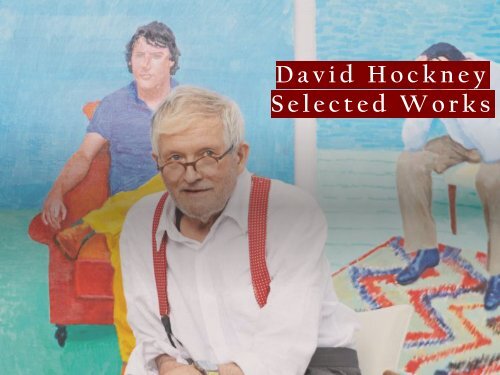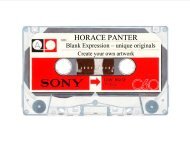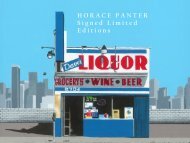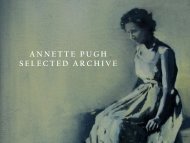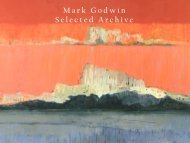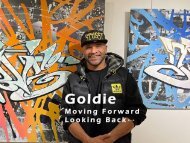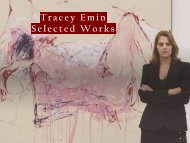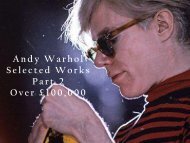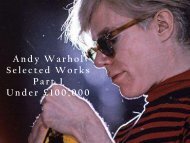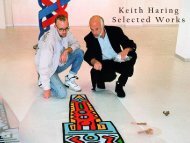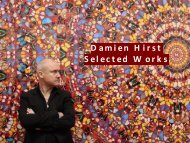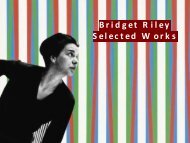David Hockney - Selected Works
Create successful ePaper yourself
Turn your PDF publications into a flip-book with our unique Google optimized e-Paper software.
D a v i d H o c k n e y<br />
S e l e c t e d W o r k s
<strong>David</strong> <strong>Hockney</strong> began his printmaking career in 1954 as a student at the Bradford College of Art before expanding his technique during his studies at the Royal Academy. His<br />
interest in new technology, and how it might lead to new processes of printmaking, developed in the 1980s and has gone on to make a lasting impact on his art and how he<br />
sees the world.<br />
‘Anyone who likes drawing or mark-making would like to explore new media,’ says <strong>Hockney</strong>. ‘I’m not a mad technical person, but anything visual appeals to me. In linocuts,<br />
for example, everything has to be bold. You don’t make tiny, thin lines in a linocut, it would be too niggly. But get an etching plate, it’s all about fine lines. Anybody who<br />
draws will enjoy that sort of variety of graphic medium: because it requires inventiveness.<br />
In February of 1986, <strong>Hockney</strong> began experimenting with a friend’s copy machine and within an hour he’d discovered it was, in fact, a new type of printing machine. The<br />
‘home-made prints’ he produced using the machine disrupted the traditional processes of colour printmaking, traditionally a painstaking process that involves many layers and<br />
experts to match each new section of the print.<br />
‘Over the years I’ve made a lot of prints working with several different master printshops,’ the artist explained. ‘It’s an exciting process, but I’ve always been bothered by the<br />
lack of spontaneity: how it takes hours and hours, working alongside several master craftsmen, to generate an image. How you’re continually having to interrupt the process of<br />
creation from one moment to the next for technical reasons.<br />
‘But with these copying machines, I can work by myself — indeed you virtually have to work by yourself; there’s nothing for anyone else to do — and I can work with great<br />
speed and responsiveness. In fact, this is the closest I’ve ever come in printing to what it’s like to paint: I can put something down, evaluate it, alter it, revise it, all in a matter<br />
of seconds.’<br />
The process of printing with the copy machine is very similar to that of a traditional colour artist’s print. Each colour is drawn onto a separate sheet of paper. That colour is<br />
then printed onto each sheet of the edition. Once one colour has been completed, the printed sheets are loaded back into the machine and a sheet with another, separate colour<br />
is placed on the copy bed.<br />
In this way, the print remains rooted in the tradition of layering ink, giving the surface depth and dimensions. Had all of the colours been printed at once from one sheet the<br />
effect would have been far less interesting, appearing ‘flat’, as you would expect from a copier, with the layers removed.<br />
In 1988, <strong>Hockney</strong> learned how to use a fax machine and began sending pictures to his friends. He even participated in the São Paolo Biennial via fax machine in 1989. He<br />
purchased a first-generation iPhone following its release by Apple in 2007, and in 2009 began experimenting in an app called Brushes. With this new technology he could<br />
create even more quickly and spontaneously. The release of the iPad in 2010 soon after allowed him a larger space.<br />
‘I love new mediums,’ he states. ‘I think mediums can turn you on, they can excite you; they always let you do something in a different way. Even if you take the same<br />
subject, if you draw it in a different way, or if you are forced to simplify it — to make it bold because it is too finicky — I like that.’
<strong>David</strong> <strong>Hockney</strong> | Landscape With Plant | 1986<br />
Homemade print executed on an office colour copy machine by the artist on paper<br />
Signed edition of 50 | 43 x 28 cm<br />
Under £23,000
<strong>David</strong> <strong>Hockney</strong> | A Round Plate | 1986<br />
Homemade print executed on an office colour copy machine by the artist on paper<br />
Signed edition of 46 | 28 x 21 cm<br />
Under £25,000
<strong>David</strong> <strong>Hockney</strong> | Apples, Grapes & a Lemon on a Table | 1988<br />
Homemade print executed on an office colour copy machine by the artist on paper<br />
Signed edition of 91 | 56 x 44 cm<br />
Under £30,000
<strong>David</strong> <strong>Hockney</strong> | Conversation in the Studio (In hand painted frame by the artist) from Moving Focus| 1984<br />
Lithograph on paper<br />
Signed edition of 45 | 80 x 67 cm<br />
Under £55,000
<strong>David</strong> <strong>Hockney</strong> | Pembroke Studio with Blue Chairs & Lamp (from Moving Focus) | 1984<br />
Lithograph on paper<br />
Signed edition of 98 | 56 x 48 cm<br />
Under £40,000
<strong>David</strong> <strong>Hockney</strong> | The Perspective Lesson (from Moving Focus) | 1984<br />
Lithograph on paper<br />
Signed edition of 50 | 56 x 76 cm<br />
Under £40,000
<strong>David</strong> <strong>Hockney</strong> | View From Hotel Well II (from Moving Focus) in artist's bespoke frame | 1984<br />
Lithograph on paper<br />
Signed edition of 75 | 93 x 75 cm<br />
Under £90,000
<strong>David</strong> <strong>Hockney</strong> | My Pool & Terrace | 1983<br />
Etching with aquatint on paper<br />
Signed edition of 250 | 107 x 74 cm<br />
Under £25,000
<strong>David</strong> <strong>Hockney</strong> | Pushing Up (AP)| 1983<br />
Lithograph and screen-print on paper<br />
Signed Artist Proof | 87 x 65 cm<br />
Under £25,000
<strong>David</strong> <strong>Hockney</strong> | Hawthorn Bush in Front of a Very Old and Dying Pear Tree | 2019<br />
Digital print on paper<br />
Signed edition of 35 | 77 x 99 cm<br />
Under £170,000
<strong>David</strong> <strong>Hockney</strong> creating a piece from<br />
the Normandy series, 2019


